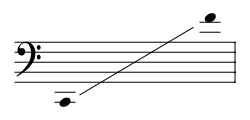Basso profondo
| Voice type |
|---|
| Female |
| Male |
Basso profondo (Italian: "deep bass"), sometimes basso profundo or contrabass, is the bass voice subtype with the lowest vocal range.

While The New Grove Dictionary of Opera defines a typical bass as having a range that is limited to the second E below middle C (E2),[1] operatic basso profondos can be called on to sing low C (C2), such as in the role of Baron Ochs in Der Rosenkavalier. Often choral composers make use of lower notes (G1 or even F1).
Definition

According to the Italian definition, any singer with an E♭2 in fortissimo is a basso profondo. Italian composers considered basso profondos as basses with a large voice, which can descend lower than the usual bass singers with a range of E2 to E4. The essential part being the large sonorous voice and not the lower register.
A historical reference of the basso profondo range was published in Jean-Jacques Rousseau's Dictionnaire de musique (1775), which states: "Basse-contres ~ the most profound of all voices, singing lower than the bass like a double bass, and should not be confused with contrabasses, which are instruments."[2]
Russian composer Pavel Chesnokov divides the bass section into these groups:
- baritones
- light basses
- strong basses
- strong basses with a good low register
- oktavists with medium range, power and a soft sound
- strong and deep oktavists
Groups 5 and 6 are considered basso profondos.
Oktavist
An oktavist is an exceptionally deep-ranged basso profondo, especially typical of Russian Orthodox choral music. This voice type has a vocal range which extends down to A1 (an octave below the baritone range) and sometimes to F1 (an octave below the bass staff).
Slavic choral composers sometimes make use of lower notes such as B♭1 in the Rachmaninov Vespers, G1 in "Ne otverzhi mene" by Pavel Chesnokov or F1 in "Kheruvimskaya pesn" (Song of Cherubim) by Krzysztof Penderecki. Russian composers often make no distinction between a basso profondo, an oktavist or a contrabass singer.
Because the voice usually takes a long time to develop and grow, low notes sound most resonant and full when the singer matures to 40 or 50 years of age; thus oktavists are often older men.[3]
Sergei Kochetov, Vladimir Miller and Mikhail Kruglov recorded a number of classic Russian folk songs and similar music, singing them in a low-pitched key to invoke the old oktavist tradition which dates back to the Tzar's court.
Notable basso profondos
Operatic
- Ludwig Fischer (1745–1825), the first Osmin in Die Entführung aus dem Serail
- Feodor Chaliapin (1873–1938)
- Maxim Mikhailov (1893–1971)
- Ludwig Weber (1899–1974)
- Josef Greindl (1912–1993)
- Martti Talvela (1935–1989)
- Kurt Moll (born 1938)
- Matti Salminen (born 1945)
- Kurt Rydl (born 1947)
Oktavists
Other
- Tim Storms (1972-)
- Thurl Ravenscroft (1914–2005)
- Avi Kaplan of Pentatonix (1989-)
- Arnold Hyles
- Richard Sterban of The Oak Ridge Boys (1943-)
- Tim Foust of Home Free (group)
- Cody Jeter (oktavist)
- Glenn Miller
- Eric Hollaway
See also
 The dictionary definition of basso profondo at Wiktionary
The dictionary definition of basso profondo at Wiktionary- Voice type
- Fach
- Vocal range
- Vocal weight
- Choir
- A cappella
- Polyphony
- Singing
References
- ↑ Owen Jander, Lionel Sawkins, J. B. Steane, Elizabeth Forbes (ed L Macy). "Bass". Grove Music Online. Archived from the original on 13 June 2006. Retrieved 14 June 2006.; The Oxford Dictionary of Music gives E2 to E4 or F4
- ↑ Jean-Jacques Rousseau (1775). Dictionnaire de musique (in French). Paris. p. 66.
Basse-Contres ~ les plus graves de toutes les Voix, qui chantent la Basse sous la Basse même, & qu'il ne faut pas confondre avec les Contre-basses, qui sont des Instruments.
- ↑ Croan, Robert (7 October 2010). "The basses of 'the Barber'". Pittsburgh Post-Gazette. Retrieved 17 October 2010.
- Smirnov, Georgy (1999). Basso Profondo From Old Russia (CD Liner notes). "The Orthodox Singers" male choir. Moscow Conservatory: Russian Season. RUS 288 158. Retrieved 8 April 2015.
- Camp, Philip Reuel (2002). A Historical and Contextual Examination of Alexandre Gretchaninoff's Second Liturgy of St. John Chrysotom, Opus 29 (PDF) (PhD. Thesis). Texas Tech University. Retrieved 8 January 2009.
- Ritzarev, Marina (2006). Eighteenth-century Russian Music. Ashgate Publishing, Ltd. p. 255. ISBN 0-7546-3466-3. Retrieved 8 April 2015.
Further reading
- Morosan, Vladimir Choral Performance in Pre-revolutionary Russia, UMI Research Press, 1986. ISBN 0-8357-1713-5
- Rommereim, J. C., "The Choir and How to Direct It: Pavel Chesnokov's magnum opus", Choral Journal, Official Publication of the American Choral Directors Association, XXXVIII, no. 7, 1998